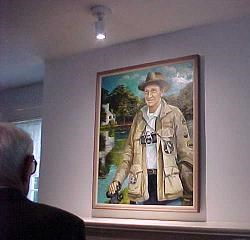
NPS Photo Millions of people each year enjoy the natural, cultural, and recreational resources of the C&O Canal, making it one of the most heavily visited national parks in the country. Yet, many visitors don't realize that this beautiful strip of land alongside the Potomac River was almost paved over. The Potomac ParkwayIn 1938, the US government purchased the right of way of the 184.5 mile long canal. Unused as a commercial waterway since 1924, the government hoped to restore it as a natural recreational area. The first 22 miles of the canal had been repaired and rewatered when World War II restrictions halted the remainder of the project. After the war, Congress came up with what it thought would be a better use of the canal. The representatives appropriated $40,000 for a joint survey and report on the feasibility of using the land for a vehicular parkway. They felt a road could provide people with better access to the beauty and recreational opportunities of the Potomac River Valley. They also felt it would provide economical assistance to many towns in western Maryland. On January 3, 1954 an editorial in the Washington Post endorsed the government's plan. One reader in particular disagreed with the idea of experiencing nature from the seat of a car. It was US Supreme Court Justice William O. Douglas and the actions he took helped save the C&O Canal. Douglas Speaks UpWilliam O. Douglas, an avid outdoorsman, devoted much of his personal time to saving the environment. He often spoke and wrote on the importance of conservation. He fought to preserve the natural state of rivers and lead successful campaigns to stop construction of dams in Kentucky, Arkansas, Illinois, and Washington. When in Washington, DC, he often hiked along the canal. He said he was grateful that an accident of history created a continuous strip of park land along one of America's most beautiful rivers. Justice Douglas felt that the long-neglected canal, like the river, was rich in beauty, history, wildlife, and recreational opportunities. He felt it needed to be preserved and maintained. He wrote a letter to the editors of the paper. Realizing that words alone could not save the canal from being paved over, he issued a challenge in his letter. His letter, which appeared in the January 19, 1954 edition of the Washington Post, was the first step toward the eventual establishment of the Chesapeake and Ohio Canal National Historical Park.
The editors of the Washington Post accepted his challenge to hike the entire length of the canal. Justice Douglas assumed the hike would consist of three or four people simply backpacking along the canal. However, news of the walk spread and many other conservationists asked to join the hiking party. A Tough, Exciting HikeThe hiking group grew to 58 by the time it left Cumberland on March 20. The group included Dr. Olaus Murie, president of the Wilderness Society, and Sigurd Olson, president of the National Parks Association. The group also included experts on geology, geography, ecology, history, ornithology, and mammalogy. Each night the group was treated to lectures on what it had seen and would see the next day. Sporting clubs along the route hosted the group in the evenings, various organizations prepared and served meals, and a trail club transported the gear so the hikers wouldn't have to carry it. Although these additions made the trip more enjoyable, it was still a difficult hike. The hikers averaged 23 miles a day, and Justice Douglas set a brisk four mile per hour pace. They even had to contend with a driving snow storm on the second day of the eight day hike. In fact, only nine men, including the 55 year old justice, completed the entire hike. Incidents along the way inspired Sigurd Olson and others to compose "The Canal Song" and each night new stanzas were added to reflect the events of the day. There were 31 verses by the end of the trip. The following provide some insight into the hardships faced by the group.
The Hike Makes NewsAs the hike progressed, one man's effort to save a piece of wilderness became a big news story. Wire services spread word of the hike to thousands of newspapers across the country. Time magazine ran a story. Movie theaters showed a newsreel of the hike. Reporters conducted interviews with Justice Douglas as he walked. Photographers captured the hike on film. People came out to hike with the justice. School children and townspeople shouted their support as the group passed by their towns. Support grew in favor of saving the canal. After seeing and experiencing nature up close and personal, the editors of the Washington Post reversed their positions and supported canal preservation. The Hike's LegacyOn the last night of the hike, the justice organized a committee that would make recommendations and draft plans for preserving and protecting the canal's resources. He served as chairman of this group (which became the C&O Canal Association in 1957) which worked toward creating an expanded canal park. Years of effort to preserve, restore, and develop this remarkable strip of land culminated on January 8, 1971 with the passage of The Chesapeake and Ohio Canal National Historical Park Act. William O. Douglas proved that one man can help make a difference. In 1977 the park was officially dedicated to the man who saved the canal. Each year the C&O Canal Association holds a canal hike in his honor. Late in life, someone asked the justice how he would like to be remembered. Although he was involved in many landmark decisions while serving on the Supreme Court, he replied as someone who tried to make the earth a little more beautiful. |
Last updated: November 21, 2025
